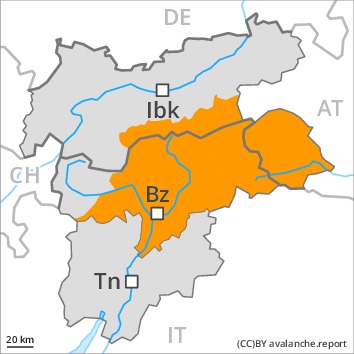
Danger level
 | treeline |
|  |
|  | ||||
|  |
|  |

A precarious avalanche situation will persist in some cases.
The fresh snow and the extensive wind slabs formed by the strong to storm force westerly wind can be released by a single winter sport participant. Caution is to be exercised in particular on very steep slopes, as well as at transitions from a shallow to a deep snowpack especially at high altitudes and in high Alpine regions. Avalanches can penetrate deep layers and reach dangerously large size. The prevalence of avalanche prone locations and likelihood of triggering will increase with altitude. Remotely triggered avalanches are possible in isolated cases.
The danger of natural dry avalanches will decrease. From origins in starting zones where no previous releases have taken place only isolated avalanches are possible. In the regions exposed to a lot of wind this applies.
The danger of gliding avalanches will persist. Areas with glide cracks are to be avoided as far as possible.
Extensive experience in the assessment of avalanche danger is required.
Snowpack
dp.6: cold, loose snow and wind
dp.2: gliding snow
Over a wide area 5 to 10 cm of snow, and even more in some localities, will fall above approximately 1000 m.
In the regions exposed to the foehn wind moderate northerly wind. In some places new snow and wind slabs are lying on soft layers. This applies at high altitudes and in high Alpine regions.
Avalanche prone weak layers exist in the centre of the snowpack. Towards its base, the snowpack is faceted.
The snowpack will be moist at low and intermediate altitudes.
Tendency
The avalanche danger will decrease gradually.


